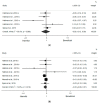Associations of Sedentary Time with Heart Rate and Heart Rate Variability in Adults: A Systematic Review and Meta-Analysis of Observational Studies
- PMID: 34444256
- PMCID: PMC8391190
- DOI: 10.3390/ijerph18168508
Associations of Sedentary Time with Heart Rate and Heart Rate Variability in Adults: A Systematic Review and Meta-Analysis of Observational Studies
Abstract
Purpose: To evaluate if sedentary time (ST) is associated with heart rate (HR) and variability (HRV) in adults.
Methods: We systematically searched PubMed and Google Scholar through June 2020. Inclusion criteria were observational design, humans, adults, English language, ST as the exposure, resting HR/HRV as the outcome, and (meta-analysis only) availability of the quantitative association with variability. After qualitative synthesis, meta-analysis used inverse variance heterogeneity models to estimate pooled associations.
Results: Thirteen and eight articles met the criteria for the systematic review and meta-analysis, respectively. All studies were cross-sectional and few used gold standard ST or HRV assessment methodology. The qualitative synthesis suggested no associations between ST and HR/HRV. The meta-analysis found a significant association between ST and HR (β = 0.24 bpm per hour ST; CI: 0.10, 0.37) that was stronger in males (β = 0.36 bpm per hour ST; CI: 0.19, 0.53). Pooled associations between ST and HRV indices were non-significant (p > 0.05). Substantial heterogeneity was detected.
Conclusions: The limited available evidence suggests an unfavorable but not clinically meaningful association between ST and HR, but no association with HRV. Future longitudinal studies assessing ST with thigh-based monitoring and HRV with electrocardiogram are needed.
Keywords: autonomic regulation; heart rate variability; lifestyle behaviors; sedentary time; vagal activity.
Conflict of interest statement
The authors declare no conflict of interest.
Figures





References
-
- Heidenreich P.A., Trogdon J.G., Khavjou O.A., Butler J., Dracup K., Ezekowitz M.D., Finkelstein E.A., Hong Y., Johnston S.C., Khera A., et al. Forecasting the future of cardiovascular disease in the United States: A policy statement from the American Heart Association. Circulation. 2011;123:933–944. doi: 10.1161/CIR.0b013e31820a55f5. - DOI - PubMed
-
- Perk J., De Backer G., Gohlke H., Graham I., Reiner Ž., Verschuren M., Albus C., Benlian P., Boysen G., Cifkova R., et al. European Guidelines on cardiovascular disease prevention in clinical practice (version 2012) The Fifth Joint Task Force of the European Society of Cardiology and Other Societies on Cardiovascular Disease Prevention in Clinical Practice (constituted by representatives of nine societies and by invited experts) Developed with the special contribution of the European Association for Cardiovascular Prevention & Rehabilitation (EACPR) Eur. Heart J. 2012;33:1635–1701. - PubMed
-
- Tremblay M.S., Aubert S., Barnes J.D., Saunders T.J., Carson V., Latimer-Cheung A.E., Chastin S.F., Altenburg T.M., Chinapaw M.J. Sedentary behavior research network (SBRN)–terminology consensus project process and outcome. Int. J. Behav. Nutr. Phys. Act. 2017;14:75. doi: 10.1186/s12966-017-0525-8. - DOI - PMC - PubMed
-
- Ekelund U., Steene-Johannessen J., Brown W.J., Fagerland M.W., Owen N., Powell K.E., Bauman A., Lee I.-M., Series L.P.A., Lancet Sedentary Behaviour Working Group Does physical activity attenuate, or even eliminate, the detrimental association of sitting time with mortality? A harmonised meta-analysis of data from more than 1 million men and women. Lancet. 2016;388:1302–1310. doi: 10.1016/S0140-6736(16)30370-1. - DOI - PubMed
-
- Pandey A., Salahuddin U., Garg S., Ayers C., Kulinski J., Anand V., Mayo H., Kumbhani D.J., de Lemos J., Berry J.D. Continuous dose-response association between sedentary time and risk for cardiovascular disease: A meta-analysis. JAMA Cardiol. 2016;1:575–583. doi: 10.1001/jamacardio.2016.1567. - DOI - PubMed
Publication types
MeSH terms
LinkOut - more resources
Full Text Sources
Medical
Miscellaneous

